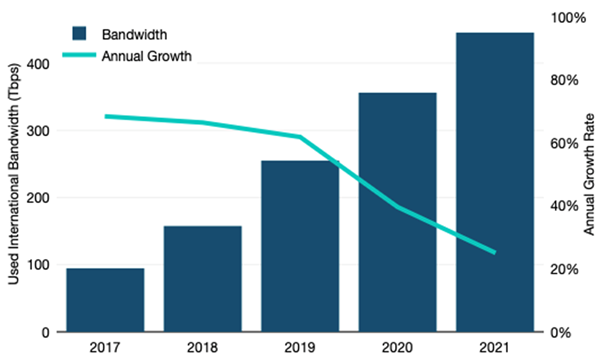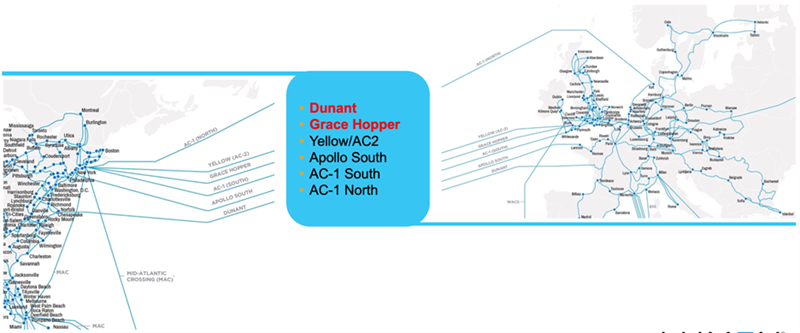The Transatlantic Route – Reigning King of the Seas
The transatlantic submarine corridor connecting Europe to North America carries more data traffic than any other submarine corridor. It carries more than twice the traffic of the 2nd and 3rd most trafficked routes, which are the transpacific and intra-Asia routes, respectively. Looking out to the year 2028, the transatlantic route shows no signs of relinquishing its throne for the route with the most data flowing between continents.
According to industry analyst firm TeleGeography, more than 90Tb/s of new transatlantic capacity was added in 2021 alone. How big was this capacity addition? Well, it’s equivalent to building all international links from the 2013 internet for the whole world – in one year. Now that’s impressive growth! Even more impressive is that an additional 136Tb/s is expected to be added in 2022, which will be a record year for new capacity.

Figure 1: Transatlantic international bandwidth (source: TeleGeography)
Over a century and a half in the making
The transatlantic submarine route had an early jump on other routes when the first telegraph cables were laid over 150 years ago. There were several false starts but ultimately these telegraph cables, which pale in comparison to the amount of traffic modern submarine cables carry, were the initial steps towards the creation of the biggest structure by distance created by humankind – the global internet of today.
For historical, political, and economic reasons the transatlantic corridor was the first to connect continents to share electronic telecommunications between humans. However, most of the traffic carried today on this route, and increasingly on other routes around the world, is data flowing between machines situated in massive data centers that enables video streaming, cloud-based services, social media, and other services related to the digital transformation juggernaut that’s rapidly consuming our personal and professional lives.
New Submarine Cables
To maintain pace with bandwidth demand growth from both wholesaler Communications Service Providers (CSPs) and Internet Content Providers (ICPs), several new submarine cables were announced in recent years such as MAREA, Grace Hopper, and Dunant. These new cables leverage several innovative wet plant technology enhancements, such as Spatial Division Multiplexing (SDM), that provide submarine cable capacities of unprecedented levels, which are dependent not just on the wet plant itself, but the chosen Submarine Line Terminal Equipment (SLTE) modem technology as well. When the wet plant and SLTE are optimized for each other, unheard of capacities are achieved as close to the Shannon Limit as possible.
Healthy transatlantic wholesale market
Much attention these days is given to ICPs, and rightfully so given their impressive bandwidth growth, share of the transatlantic corridor bandwidth, and ongoing investment in new submarine cables and associate technologies. However, there’s still a healthy market for wholesale submarine network services. ICPs use their fiber pairs primarily for internal Data Center Interconnection (DCI) purposes, so if you want to connect across the transatlantic, or any submarine corridor, CSPs make this possible (as they always have in the past). How big is the transatlantic wholesale market opportunity? TeleGeography estimates a healthy 58Tb/s of transatlantic capacity demand to be addressable by wholesale CSPs in 2021 alone.
Lumen addresses transatlantic wholesale service growth
Lumen has multiple submarine cables crisscrossing the globe totaling over 75,000 kilometers. Additional capacity from their new Grace Hopper and Dunant submarine cable assets will enhance their already expansive transatlantic network. Not only will these new submarine cables add a substantial amount of new capacity, but they’ll also enhance the diversity of Lumen’s transatlantic network with new cable routes and cable landings. Given submarine networks are critical infrastructure, being the jugular veins of international connectivity, the benefits associated with increased diversity simply cannot be over-emphasized.

Figure 2: Lumen’s transatlantic network over multiple diverse routes
Webinar
If you’d like to learn more about the transatlantic submarine cable route, you can register for the free on-demand webinar entitled, “How Lumen Successfully Expanded Its On-Net Transatlantic Portfolio”. In this webinar, you’ll learn about transatlantic bandwidth, pricing, diversity, and content provide data center plans. You’ll also hear how Lumen recently expanded its transatlantic service portfolio to include the new Dunant and Grace Hopper submarine cable systems that interconnect major data center hubs along the Virginia to Paris and New York/New Jersey to London submarine network corridors, respectively. You’ll also hear about Ciena’s freely downloadable Open Submarine Cable Handbook Series covering key considerations every cable operator should know.





